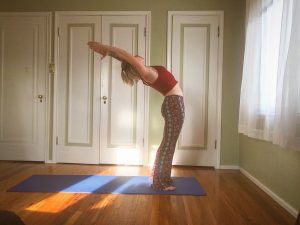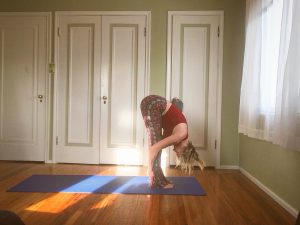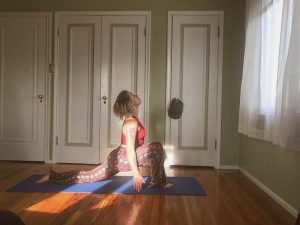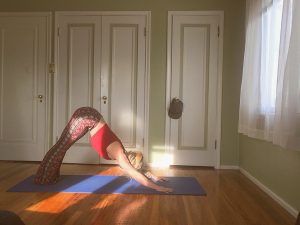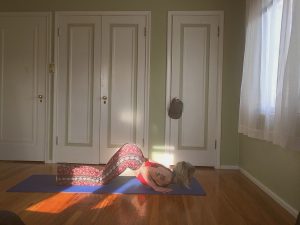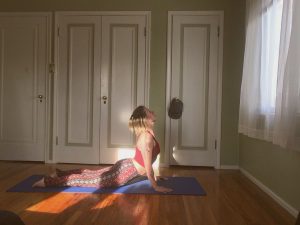This 15-minute yoga series will do wonders for your clients. It targets every major muscle group and joint in the body.
As professionals in the fitness industry, trainers are sure to know at least a bit about yoga, if not a whole lot. Many trainers are also yoga teachers, myself included. However, for those of you that are not this next bit is for you to help integrate yoga into your training practices.
The Yoga Revolution
I am happy to report that yoga is finally being recognized as a legitimate fitness and wellness practice. Yoga has proven to be a primary and secondary preventative method for a multitude of psychological and physical health conditions.
“Researchers have postulated that yogic relaxation and breathing techniques may reduce blood pressure by inducing slow rhythmic proprioceptive and exteroceptive impulses, reducing peripheral adrenergic activity, and facilitating autonomic balance, which reduces chemoreceptor responses and enhances baroreflex sensitivity.”(Yoga and Hypertension: A Systematic Review).
Yoga’s practice of slowing down and relaxing the mind and body has been shown to give practitioners complimentary and beneficial relationships between the sympathetic and parasympathetic branches of the autonomic nervous system.
In addition, achieving the slow rhythmic proprioceptive and exteroceptive impulses gives the body a more comprehensive awareness of posture, muscle movement and the ability to orient itself without visual cues. Simply put, yoga quit literally centers the body; with autonomic balance, homeostasis occurs and practitioners experience enhanced coordination.
Surya Namaskar – Sun Salutation
For the trainer that doesn’t have much background in yoga, it’s difficult to prescribe this wonderful practice. Luckily I have you covered. Here I have laid out the famous Hatha Surya Namaskar series. Doing just this series for 15 minutes a day will do wonders for clients who struggle terribly with mobility and stiff joints. The Sun Salutation series targets every major muscle group and joint in the body.
Not only will it promote improved flexibility, but the added benefit of bringing mental rejuvenation and emotional wellness! It is also a strengthening practice. It requires strength, body awareness and coordination to perform the Surya Namaskar. Meaning that with time all of these aspects of your client will be improved. This is also a good suggestion for clients asking about beginner’s yoga.
1: Pranamasana – Salutation Pose
This is the beginning posture in your Hatha Surya Namaksar. Standing tall, engage the abdominal muscles to maintain a long, neutral spine. Tail bone should be pointing down towards the earth. Palms gently press together, elbows out to the side, shoulders rolled back opening the chest and heart center. Gaze (dristi) is ahead, with chin parallel to the ground.

2: Hasta Uttanasana – Arms raised pose
From Pranamasana inhale as you arch up and back through the spine reaching the hands, shoulder distance apart, overhead. Being sure not to compress in the lower spine, even though this is a bend elongating the spine is still important to keep in mind. This is done by squeezing the glute muscles and staying engaged in the abdominal muscles. Neck is relaxed in this pose.
3: Uttanasana – forward bend or hands to feet pose
From Hasta Uttanasana exhale arms forward and down into the forward bend. Notice in the image that my head is not hanging down. In this pose try to maintain a straight spine rather than rounding through the back and forcing the head towards the shins. This is done by strongly engaging the core muscles and drawing the navel back towards the spine.
4: Ashwa Sanchalanasana – Equestrian Pose or horse riding pose
From Uttanasana inhale as the right foot steps back. Either curling the toes and grounding through the ball of the right foot, or pressing into the top of the right foot. The front knee must be aligned over the front ankle, the weight distributing down into the front heel rather than the toes. It should be easy to lift the toes in this pose if the weight is distributed properly. Arch up through the spine and neck to bring the dristi (gaze) towards the ceiling. The fingers reach for the ground, roll the shoulders back and melt them away from the ears, keeping the chest lifted and open.
5: Parvatasana – Mountain Pose
From Ashwa Sanchalanasana exhale as the palms press into the mat and the left foot steps back to meet the right. Draw the heels down towards the mat, flexing through the muscles of the legs to do so. The biceps are aligned with the ears, the drisit (gaze) is directly down towards the mat. Press the hips high, drawing the navel back towards the spine to maintain a long straight spinal column. Keep the neck free by pressing the shoulder heads away from the ears, feeling the shoulder blades slide down the back towards the tailbone.
This pose is very similar to the Adho Mhuka Svanasana, Downward Facing Dog. The difference is in the placement of the feet. Unlike Adho Mhuka Svanasna, in Parvatasana the feet are touching each other in a centered position.
6: Ashtanga Namaskar – Eight Limbed Pose
From Parvatasana keep the hands and feet in place; exhale as the elbows bend diving the chest forward and down. Keep the hips high, first contact with floor starting with chin, then chest, followed by the knees. In total the chin, hands, chest, knees and toes are making contact with the mat, hence eight limb pose. The elbows squeeze in towards the body aligning with the torso. The elbows should not be pointing up towards the ceiling. To avoid this, roll the shoulders back and down.
7: Bhujangasana – Cobra Pose
From Ashtanga Namaskar keep the hands in place, inhaling as you press into the hands lifting the chest and lengthening through the body. Press the tops of the feet into the mat so even the pinky toes make contact. Squeeze the elbows towards the body keeping a slight bend in the joint. It is very common for the shoulders to shrug up towards the ears in this pose. Remember to press the shoulder heads down keeping the shoulders in their sockets. The chest is lifted and the drisit is up towards the ceiling.
8: Parvatasana – Mountain Pose
From Bhujangasana keep the hands in the same position, exhale as the hips shift up and roll over the feet so the heels may press down into the mat.
9: Ashwa Sanchalanasana – Equestrian Pose or Horse Riding Pose
From Parvatasana inhale as the left leg draws under the body and steps between the hands at the top of the mat. Push the pelvis forwards and lift the torso and tilting the head back, arching the back and looking up to the sky.
10: Uttanasana – Forward bend or hands to feet pose
From Ashwa Sanchalanasana exhale as the right foot steps forward to meet the left and straightening through the knees.
11: Hasta Uttanasana – Hands raised pose
From Uttanasana inhale the hands up and overhead, arching through the spine and pressing the hips forward.
12: Pranamasana – Salutation Pose
From Hasta Uttanasana exhale as the palms come together drawing the hands down through to heart center. Coming to a full standing position, ending where you had begun. Repeating the sequence, but stepping back with the right foot from Uttanasana to Ashwa Sanchalanasana and moving through the series again. This series can be worked through as many times as needed, alternating which foot steps back first.
The great thing about yoga is that there is a lot of room to make it your own. These asanas can be worked individually within training sessions with clients, and the sequence itself can be tweaked and modified to fit every individual.
If you are fitness professional unfamiliar with yoga and it’s different styles, I certainly suggest giving the Surya Namaskar a try yourself. Perhaps becoming a yoga teacher is in your continuing education future.
References
Tyagi, AnupamaCohen, Marc. “Yoga And Hypertension: A Systematic Review.” Alternative Therapies In Health & Medicine 20.2 (2014): 32-59. Alt HealthWatch. Web. 8 May 2014.
